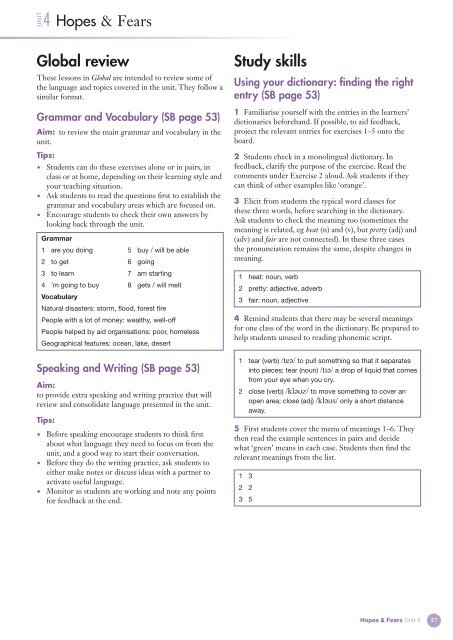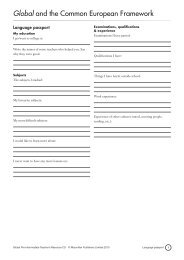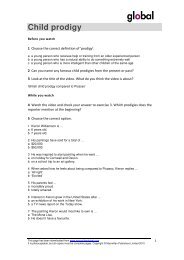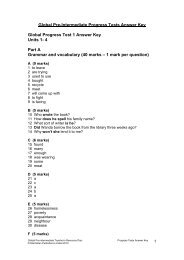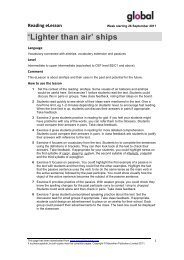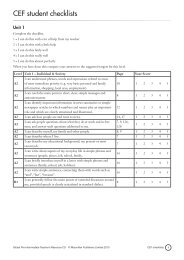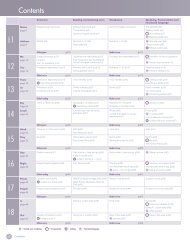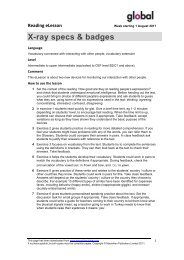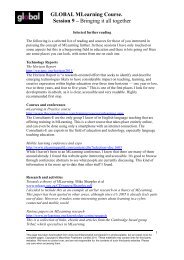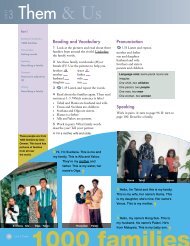Teacher's Book teaching notes - Global
Teacher's Book teaching notes - Global
Teacher's Book teaching notes - Global
You also want an ePaper? Increase the reach of your titles
YUMPU automatically turns print PDFs into web optimized ePapers that Google loves.
UNIT4Hopes & Fears<strong>Global</strong> reviewThese lessons in <strong>Global</strong> are intended to review some ofthe language and topics covered in the unit. They follow asimilar format.Grammar and Vocabulary (SB page 53)Aim: to review the main grammar and vocabulary in theunit.Tips:• Students can do these exercises alone or in pairs, inclass or at home, depending on their learning style andyour <strong>teaching</strong> situation.• Ask students to read the questions first to establish thegrammar and vocabulary areas which are focused on.• Encourage students to check their own answers bylooking back through the unit.Grammar1 are you doing 5 buy / will be able2 to get 6 going3 to learn 7 am starting4 ’m going to buy 8 gets / will meltVocabularyNatural disasters: storm, flood, forest firePeople with a lot of money: wealthy, well-offPeople helped by aid organisations: poor, homelessGeographical features: ocean, lake, desertSpeaking and Writing (SB page 53)Aim:to provide extra speaking and writing practice that willreview and consolidate language presented in the unit.Tips:• Before speaking encourage students to think firstabout what language they need to focus on from theunit, and a good way to start their conversation.• Before they do the writing practice, ask students toeither make <strong>notes</strong> or discuss ideas with a partner toactivate useful language.• Monitor as students are working and note any pointsfor feedback at the end.Study skillsUsing your dictionary: finding the rightentry (SB page 53)1 Familiarise yourself with the entries in the learners’dictionaries beforehand. If possible, to aid feedback,project the relevant entries for exercises 1–5 onto theboard.2 Students check in a monolingual dictionary. Infeedback, clarify the purpose of the exercise. Read thecomments under Exercise 2 aloud. Ask students if theycan think of other examples like ‘orange’.3 Elicit from students the typical word classes forthese three words, before searching in the dictionary.Ask students to check the meaning too (sometimes themeaning is related, eg heat (n) and (v), but pretty (adj) and(adv) and fair are not connected). In these three casesthe pronunciation remains the same, despite changes inmeaning.1 heat: noun, verb2 pretty: adjective, adverb3 fair: noun, adjective4 Remind students that there may be several meaningsfor one class of the word in the dictionary. Be prepared tohelp students unused to reading phonemic script.1 tear (verb) /teə/ to pull something so that it separatesinto pieces; tear (noun) /tɪə/ a drop of liquid that comesfrom your eye when you cry.2 close (verb) /kləʊᴢ/ to move something to cover anopen area; close (adj) /kləʊs/ only a short distanceaway.5 First students cover the menu of meanings 1–6. Theythen read the example sentences in pairs and decidewhat ‘green’ means in each case. Students then find therelevant meanings from the list.1 32 23 5Hopes & Fears Unit 4 57


